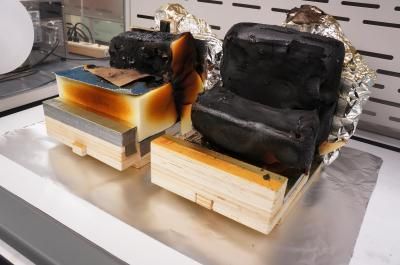Ways to improve common furniture fire test
Advertisement
The bench-scale test widely used to evaluate whether a burning cigarette will ignite upholstered furniture may underestimate the tendency of component materials to smolder when these materials are used in sofas and chairs supported by springs or cloth, National Institute of Standards and Technology (NIST) and American University researchers report in a new study.

Residues of an identical foam-fabric assembly in the current (left) and in the modified (right) smoldering ignition setup (45 min test duration). The new setup promoted an increase in smoldering rate as compared to the current setup and induced transition to flaming.
Zammarano/NIST
The study comes as regulations and methods for evaluating the likelihood that soft-furniture materials will ignite are undergoing scrutiny. In November 2013, California removed an open-flame test from its furniture flammability testing law**-the de facto national standard since no national regulation currently exists-and now relies solely on the so-called cigarette-smoldering-ignition test.
The new research identifies changes to this test that might make it more realistic-representative of a "near-worst-case scenario." The modifications, the researchers write, would make the test more consistent and, therefore, more useful for identifying "upholstery materials most likely to prevent smoldering ignition."
In the same article, the research team reports guidelines for making a reproducible reference foam for furniture flammability testing-a challenging, longstanding priority of standards developers, regulators and fire researchers. Such a standardized foam would help in comparing flammability data from different laboratories.
In the current setup for the test, two fabric-covered foam pieces are positioned like seat and back cushions on a small solid wood support structure. A lit standard reference cigarette (one certified by NIST to burn consistently) is placed in the crevice formed by the two pieces. To pass, a fabric covering or barrier material under test must prevent the burning cigarette from igniting the underlying foam so that it does not smolder on its own, even after the cigarette self-extinguishes.
The researchers found that directly placing the test samples on top of the wooden support impedes air flow and, as a consequence, inhibits smoldering. They point out that the arrangement is not representative of furniture with cushions that rest on air-permeable substrates such as springs or cloth, which allows air to circulate and promotes smoldering.
The team introduced gaps between the foam samples and the underlying wood, permitting air flow. The adjustment increased-by up to threefold-the rate at which smoldering spread in the foam. It also generated significantly higher smoldering temperatures in the foam-as much as 400 degrees Celsius higher.
"Because it inhibits air flow, the current test apparatus may diminish the propensity for smoldering ignition," explains NIST's Rick Davis. "Creating gaps to increase air flow, and the other modifications we are suggesting-especially adoption of a reference foam-will enable more consistent smoldering behavior and help to minimize other causes of inconsistent flammability test results."
Either overlooked or considered unavoidable, differences in foam samples can be a significant source of ambiguity in flammability test results. Whether a lit cigarette burning on, say, a fabric covering initiates self-sustained smoldering in the underlying foam depends on whether the heat produced exceeds the heat lost. Both heat generated and heat loss are affected by the foam's internal physical structure, as well as other factors.
So, identical swatches of furniture fabric might pass one lab's cigarette-smoldering-ignition test and fail another's because the foam samples were not uniform.
The researchers' guidelines for making a standard reference foam focus on achieving uniformly sized pores, or open cells, that are arrayed throughout the material's internal, Swiss-cheese-like interior. Their experiments indicate that, for a given formulation, samples with same-sized open cells will smolder similarly.
The team found that the process for making polyurethane foams with a network-like, open-cell structure can be controlled sufficiently to minimize differences in cell size so that smoldering behavior is consistent across test samples. In fact, they say, the average cell size can be "easily tuned" so that the sample mimics the smoldering intensity observed in foams used in actual upholstered furniture.
Nationwide, fires in which upholstered furniture is the first item ignited account for about 6,700 home fires annually and result in 480 civilian deaths, or almost 20 percent of home fire deaths between 2006 and 2010, according to the National Fire Protection Association.





























































